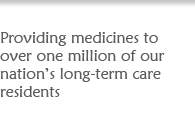|
March 6, 2006 | IN THIS ISSUE:
New York: Nursing Homes Call Part D Billing Problems a "Colossal Mess"
The Utica, New York Observer Dispatch reports:
Nursing homes weren't supposed to pick up the drug tabs, but some drug plans didn't follow guidelines for the dual eligibles and either wrongly charged residents co-payments or didn't cover first fills of prescriptions that weren't on the plan's list of covered drugs, among other mistakes, nursing home officials said.
This left nursing homes in a tricky situation. They said they'll make sure residents get their drugs and will probably eventually get reimbursed for the costs they're incurring. The problem is the time in between. Many nursing homes in New York are strapped for cash, with most losing money, according to 2003 data, the most recent available, from the New York Association of Homes and Services for the Aging. They said tight finances also should be reflected in 2004 and 2005 data.
So, as it comes time to pay January pharmacy bills, they will need to consider options such as borrowing money to cover the costs or brokering payment deals with pharmacies, said Patrick Cucinelli, the association's senior financial policy analyst.
"But it's too soon to tell," he added.
Heidi Viti, billing manager at Utica-based Pharmacy Solutions, which serves the pharmaceutical needs of many area nursing homes, said from her perspective, billing for the new program was going OK.
The program's performance across the nation has been spotty, but an Association of Homes and Services for the Aging spokesman said it didn't surprise him that nursing homes in the Mohawk Valley didn't have the billing problem.
"You guys should count yourself lucky its not that bad there," spokesman Dan Curran said. "I've read many stories from other parts of the country where it's different in the suburbs of a city than in the city proper, and it's just a colossal mess."
Read the Full Story
USA Today: Part D Red Tape Causing Problems
USA Today reports:
The Medicare prescription drug program's complex tangle of rules, paperwork and telephone delays is keeping some patients from drugs they have taken for years, doctors say. Problems cited include:
• Insurers requiring "prior authorization" on some drugs, including those to treat depression, psychosis and convulsions — even for patients who have long taken the drugs.
• Strict dosage or quantity limits on some drugs, sometimes well below what a patient takes.
• Long delays on calls to insurers to make requests. Then delays of days in getting a response.
Read full story...
CMS Reassures Governors on State Reimbursement
Reuters reports:
Mark McClellan, director of the Centers for Medicare and Medicaid Services, told a National Governors Association conference the Bush administration would soon unveil procedures for states to file reimbursement claims for Medicaid recipients unable to obtain drugs under the new Medicare Part D Program.
So-called "dual eligibles" were meant to be switched to private drug plan providers on Jan. 1, but thousands were unable obtain their prescriptions because of enrollment problems or computer glitches.
More than 40 states stepped in to pay for drugs for these people under old Medicaid drug programs. The total costs borne is not determined, but consultants estimate that it could easily reach into the billions of dollars.
Read the full story...
CMS May Limit Number of Drug Plans Offered in 2007
The Associated Press reports:
The Bush administration is looking at ways to simplify the new Medicare prescription drug benefit, but initial proposals are unlikely to win over the program's critics. In a 39-page draft memorandum to insurers, employers and others administering the drug benefit, the Centers for Medicare and Medicaid Services asked for advice on how to simplify the program in 2007.
The agency proposed limiting to two the number of drug plans a company can offer per region. Many insurers now offer three, and since there are often more than a dozen insurers per region, consumers often have more than 40 choices.
The agency also said it expects that an insurer's two plans must have meaningful differences to make comparisons easier.
The recommendations appear to be a direct response to concerns that some older and disabled people are confused by the vast array of options.
Read the full story...
Kaiser Foundation Fifty State Survey Finds Difficult Transition for Duals
The Kaiser Family Foundation has released the findings of a 50 state survey on the transition of dual eligibles into Part D. Kaiser reports:
On January 1, 2006, the prescription drug coverage for over 6 million dual eligibles was transitioned from Medicaid into the new Medicare prescription drug benefit. Almost immediately, federal, state and local officials noticed problems that made it more difficult for some dual eligibles to obtain needed prescriptions. Because dual eligibles typically have more extensive health and prescription drug needs than other beneficiaries, many states had been preparing for problems and moved forward with temporary programs to ensure that these beneficiaries obtained needed medications during the transition to the Medicare drug benefit. The federal government has since committed to reimbursing the states for the costs associated with the temporary coverage programs
Medicaid officials from all 50 states and the District of Columbia responded to the survey. It provides a state-by-state breakdown of temporary coverage programs, including the number of duals receiving prescriptions, total prescriptions, and the cost of coverage. The survey also finds that in the first month of implementation:
- Over 60 percent of states reported problems that affected a significant number of dual eligibles,
- 37 states implemented temporary coverage programs for dual eligibles, and
- The most common problems included incorrect cost-sharing charged to beneficiaries (49 states), pharmacies could not bill plans (44 states), and beneficiaries were unable to obtain non-formulary drug (43 states).
Read the full report...
Part D Providing $4 Billion In Employer Subsidies, $1.1 Billion To GM
The New York Times reports:
America's largest companies expect the federal government to pay them $4 billion during the next four years to help keep their retiree health plans alive at a time when such benefits increasingly are on the chopping block, according to a new study by Credit Suisse First Boston.
The money is due to start flowing to employers this month as part of Medicare's new prescription-drug benefit. When Congress authorized the Medicare drug benefit, it agreed to start subsidizing the drug component of employers' retiree health plans, to keep them from shifting their retirees into the government program.
The goal is to save the government money, even after the subsidies. Among the nation's 500 largest companies, 331 offer retiree health plans. With the program starting its first year, it is not yet clear whether the subsidy will achieve its goals. For one thing, about 36 million people in this country age 65 and older are eligible for Medicare, but only about 7 million retirees currently are covered by employer-sponsored health plans.
Still, the Credit Suisse study shows that the subsidy is popular with big employers, even those that do not fit the stereotype of companies in waning industries unable to cope with health care inflation and armies of baby-boomer retirees.
The money will flow to financially weaker companies staggering under the weight of their health plans, like General Motors, which is expected to receive $1.1 billion in the next four years in retiree drug subsidies.
Read the full story...
Maryland Study Finds More Nursing Homes Residents Lack Drug Coverage Than Expected
HealthCentral.com reports:
There's a greater than expected need for the new Medicare drug benefit in U.S. nursing homes, where 20 percent of residents lack prescription drug coverage, says a University of Maryland study in the March issue of the journal Medical Care.
Of the nursing home residents without prescription drug coverage, 37 percent have incomes below the federal poverty level and 35 percent have incomes between 100 and 200 percent of the poverty level.
The study authors concluded that "there is a much greater need for Part D drug coverage among nursing home residents than commonly thought." They also found that many nursing home residents would likely qualify for subsidized Part D coverage for those with low incomes.
The authors noted that 56 percent of nursing home residents on Medicare also qualify for Medicaid. This could leave them vulnerable to changes in access to drugs that they need as the system switches from Medicaid to Medicare drug benefits.
Read the full story...
CMS Issues LTC Guidance on Part B/D Issues
Aiming to simply the process of identifying what is covered by Part B and what is covered by Part D, CMS has published a brief guidance for long term care providers.
Read the CMS Guidance
|


